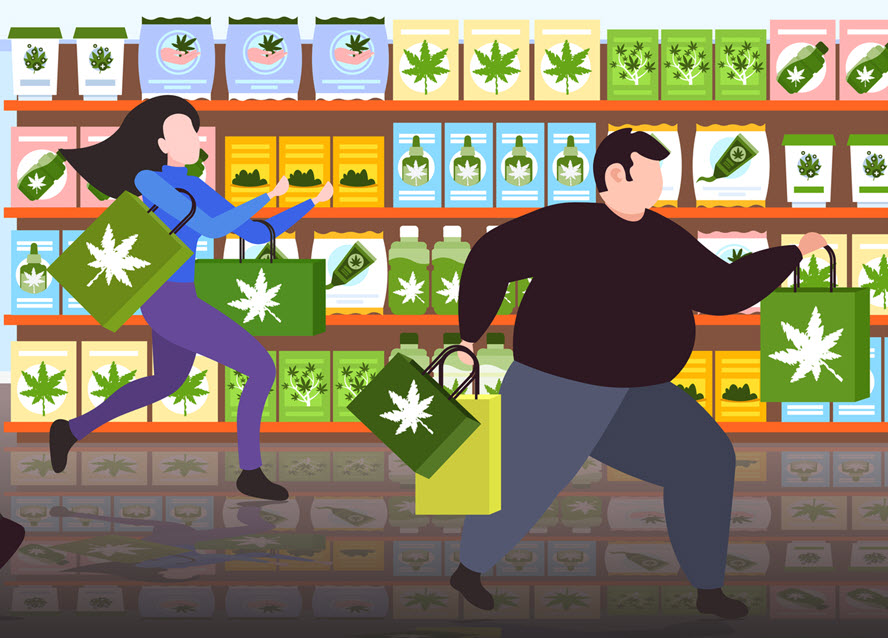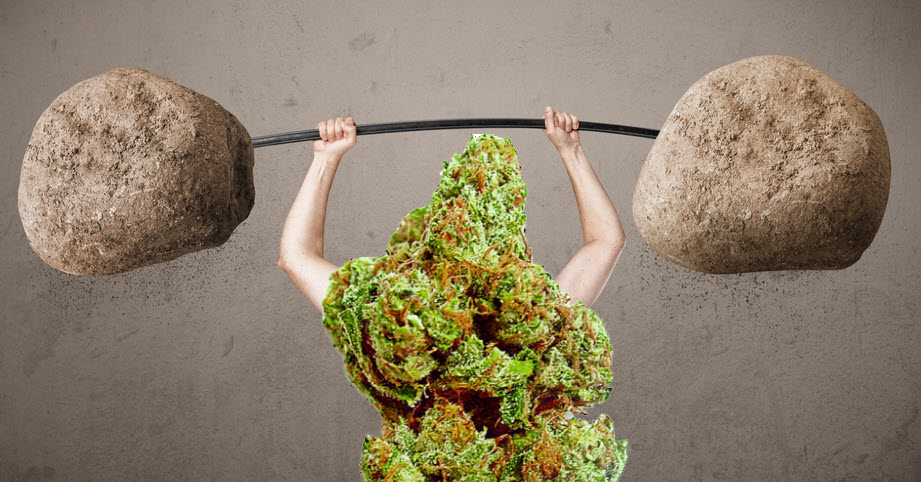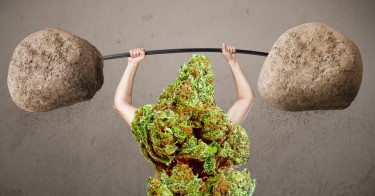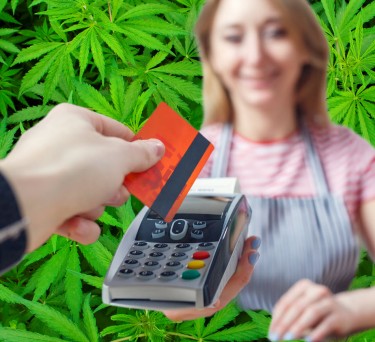Cannabis News
Most People Will Pay Higher Prices for Weed from Legal Sources if Available
Published
3 months agoon
By
admin

Most People buy from legal sources if available
In 2014, a groundbreaking commercial hit the airwaves, pushing the boundaries of cannabis advertising in a way that was both hilarious and thought-provoking. Working with MarijuanaDoctors.com, we created a scenario that would resonate with viewers: a shady character selling sushi from inside his coat on a dimly lit street corner.
The premise was simple yet effective: “Would you buy your sushi from a street dealer?” The answer, of course, was a resounding “No!” The parallel to the cannabis industry was immediately clear. Just as consumers wouldn’t risk their health with questionable street sushi, why should they gamble with unregulated cannabis?
Fast forward to today, and the landscape of cannabis consumption has dramatically shifted. What was once a bold statement is now a common reality in most U.S. states and many parts of the world. Cannabis has become a mainstream product, and recent surveys reveal a fascinating trend: when given the choice, most consumers prefer to purchase their cannabis from legal, regulated sources.
This preference for legal cannabis isn’t just a matter of convenience or quality – it represents a seismic shift in the war against illegal drug trade. For decades, prohibitionists have employed countless tactics to curb cartel drug selling, from aggressive law enforcement to public awareness campaigns. Yet, ironically, it’s legalization that has proven to be the most effective strategy in undermining the illicit market.
The implications of this trend are profound. Not only does it validate the arguments made by legalization advocates, but it also challenges long-held assumptions about drug policy and consumer behavior. As more regions embrace legal cannabis markets, we’re witnessing a real-time experiment in how regulation can address issues that prohibition failed to solve.
In this article, we’ll delve deeper into this “legalization effect,” exploring the factors driving consumers towards legal cannabis sources and the broader impact on both the industry and society. From public health concerns to economic implications, the shift towards legal cannabis purchasing is reshaping our understanding of effective drug policy in the 21st century.
The recent survey conducted by NuggMD provides compelling evidence of the “legalization effect” on cannabis purchasing habits. The findings paint a clear picture of consumer preferences in states with legal cannabis markets:
-
A striking 77% of respondents reported obtaining all or most of their cannabis from licensed retailers.
-
65% of those surveyed said they get “all” of their cannabis products through legal outlets.
-
An additional 12% stated they get “most” of their cannabis through legal sources.
-
Only 6% of respondents said they get none of their marijuana from legal stores.
These numbers are significant, especially when we consider the potential economic impact. The United Nations Office on Drugs and Crime estimates that the global illicit drug trade generates between $426 billion and $652 billion annually. If we apply the survey’s findings to this market, assuming a conservative 77% shift to legal purchases, it could potentially redirect $328 billion to $502 billion from illegal to legal channels.
The implications of such a massive shift are staggering. If this revenue were to be taxed at even a modest rate of 15%, it could generate between $49 billion and $75 billion in annual tax revenue. These funds could be channeled into public health initiatives, education, infrastructure, or drug prevention and treatment programs, providing substantial societal benefits.
What’s particularly noteworthy is that even in states like California and New York, where unlicensed stores have proliferated, consumers still show a strong preference for legal outlets. In California, 70% of respondents said they buy all or most of their marijuana from legal stores. Similarly, in New York, 68% reported always or mostly obtaining marijuana from licensed stores.
However, the survey also highlighted a challenge in these states: 6% of respondents in both California and New York said they don’t know which stores are licensed or unlicensed. This points to a need for better consumer education and more distinct licensing for retail outlets to help consumers make informed choices.
The shift towards legal purchasing has significant implications for youth access to cannabis. Licensed stores have a strong incentive to comply with age restrictions to maintain their licenses, unlike street dealers who operate outside the law. A study by the Washington State Institute for Public Policy found that compliance rates for recreational marijuana retailers in age verification were as high as 92%. This high compliance rate suggests that as more consumers shift to legal sources, it becomes increasingly difficult for underage individuals to obtain cannabis.
Moreover, the survey revealed that most respondents were daily cannabis users, suggesting that even frequent consumers prefer legal sources when available. This trend could have a snowball effect, further marginalizing the illicit market as more consumers develop habits centered around legal purchasing.
The preference for legal cannabis sources, even in states with thriving unlicensed markets, underscores the potential of regulation to reshape consumer behavior. It suggests that given the choice, most cannabis users would rather support a regulated industry that ensures product safety, quality, and legal compliance.
These findings provide strong support for the argument that legalization and regulation, rather than prohibition, may be the most effective tools in combating the illicit drug trade. By creating a framework that consumers trust and prefer, legal markets are accomplishing what decades of prohibition failed to do – significantly reducing the customer base for illegal drug sellers.
As we witness the positive outcomes of cannabis legalization, it’s crucial to step back and ask ourselves a fundamental question: Why do we have drug prohibition in the first place? The answer to this question is not as straightforward or scientifically grounded as many might assume.
The truth is, drug prohibition is not based on scientific evidence but rather on a complex web of historical, political, and cultural factors. When we examine instances of drug policy reform implemented with careful consideration, we consistently see multiple beneficial outcomes. A prime example is Portugal’s bold move in 2001 to decriminalize the possession and use of all drugs, shifting from an “enforcement paradigm” to a “harm reduction paradigm.”
The results were remarkable. Portugal saw significant drops in drug-related HIV infections, overdose deaths, and drug-related crime. Moreover, contrary to fears of increased drug use, rates of drug use in Portugal have remained below the European average. This case study demonstrates that when we approach drug policy with maturity and evidence-based strategies, positive change is not only possible but probable.
But such an approach requires a level of societal maturity that some might question whether the United States possesses. Can a nation often characterized by its extremes handle such a nuanced approach to drug policy? I would argue that it can.
While it’s true that the U.S. population might seem more prone to extremes than some other nations, the reality is that most Americans are moderate in their views and behaviors. Take alcohol, for instance. Despite its widespread availability, we don’t see a nation overrun by alcoholics. Certainly, some individuals struggle with alcohol abuse, but the majority of people either drink in moderation or abstain entirely.
There’s no reason to believe that this pattern of moderation wouldn’t extend to other substances if they were legalized and regulated. In fact, the phenomenon of decision paralysis suggests that legalizing all drugs might even deter some individuals from using any drugs at all. When faced with too many choices, people often choose none.
The key point here is that when implemented thoughtfully and within a proper framework based on scientific evaluation, legalization can be the most effective way to combat drug addiction and abuse. The data from cannabis legalization and Portugal’s decriminalization experiment support this assertion.
Legalization allows for:
-
Quality control and safer products
-
Age restrictions and regulated access
-
Tax revenue that can fund education and treatment programs
-
Reduction in criminal activity associated with the illicit drug trade
-
More open dialogue about drug use and its potential risks
It’s time for us to grow up and face the reality that prohibition has failed to achieve its goals. Instead, it has created a host of problems, from overcrowded prisons to dangerous black markets. By contrast, legalization and regulation offer a path forward that respects individual freedom while prioritizing public health and safety.
This mature approach requires us to move past fear-mongering and outdated moral panics. It demands that we base our policies on evidence rather than emotion. It asks us to trust in the general moderation of our fellow citizens, just as we do with alcohol.
The data increasingly backs up this approach. From cannabis legalization in various states to broader drug policy reforms in countries like Portugal, we see that treating drug use as a health issue rather than a criminal one leads to better outcomes for individuals and society as a whole.
It’s time to grow up, America. Let’s embrace a more mature, nuanced, and effective approach to drug policy. The evidence is clear: legalization, when done right, works better than prohibition ever did.
WHAT ABOUT CANADA, DO THEY BUY LEGAL? READ ON…
You may like
-


Magnitude vapes help the UFC’s Matt Frevola roll with the punches
-


Can Cannabis Help WIth Holiday Digestive Issues
-


Republicans May Legalize Cannabis in America, Wait, What?
-


A History of Cannabis Use in Different Cultures and Parts of the World
-


How to Fight a Marijuana DUI in Savannah, Georgia
-


Top 5 Delta 9 Edibles That Actually Work and Taste Delicious
Cannabis News
Republicans May Legalize Cannabis in America, Wait, What?
Published
6 hours agoon
November 25, 2024By
admin

Keep on Pushing! I can see a Crack in the Wall…
As I sit here rolling up my morning joint, I can’t help but marvel at how far we’ve come in the cannabis legalization movement. What was once relegated to the shadows of society, demonized by decades of propaganda and prohibition, has emerged into the mainstream with such force that even the most ardent opponents are starting to change their tune.
You know something significant is happening when Republican senators start calling cannabis rescheduling “half-assed measures” and argue for full legalization. The winds of change are blowing, my friends, and they’re carrying the sweet scent of reform with them.
Look around – despite federal prohibition, 38 states have established medical cannabis programs, and nearly half allow adult recreational use. This isn’t just progress; it’s a revolution in slow motion. The dominoes are falling one by one, and the momentum seems unstoppable. Even in states where cannabis remains illegal, there’s growing pressure from constituents who’ve witnessed the sky decidedly not falling in neighboring legal states.
But here’s what really gets me excited: I’m starting to see cracks in the great wall of prohibition. These aren’t just surface fractures – we’re talking about deep, structural weaknesses in the foundation of cannabis prohibition itself. When both Democrats and Republicans start seriously discussing federal reform, albeit from different angles, you know we’re approaching a tipping point.
The time has come to double down on our efforts. Like water wearing away at stone, our persistent push for reform is finally showing results. The barriers that once seemed impenetrable are beginning to crumble, and the path to meaningful change is becoming clearer by the day.
So, let’s dive into what’s really happening in the corridors of power, examine the shifting political landscape, and explore why this might be our moment to push through to victory. The game is changing, folks, and we’re all front-row witnesses to history in the making.
For years, we cannabis advocates have operated under the assumption that Republicans were our sworn enemies in the fight for legalization. And let’s be honest, with dinosaurs like Senator Chuck Grassley still roaming the congressional halls, it’s not an entirely unfair assessment. However, something interesting has been happening over the past few years – support for cannabis reform has quietly been creeping across party lines.
Case in point: Senator Thom Tillis from North Carolina (not exactly a bastion of progressive drug policy) recently dropped a truth bomb that had me nearly dropping my bong in surprise. He called the current attempts at rescheduling cannabis and banking reform “half-measures—we could even argue half-assed measures.” Coming from a Republican senator, those words carry serious weight.
But Tillis didn’t stop there. He went on to argue that we’re “dancing around the issue” and need “one consistent framework” for cannabis regulation, similar to alcohol and tobacco. His vision includes authenticating crops, mandating proper FDA oversight of products, and allowing banking access. Holy smokes, folks – this is exactly what many of us have been preaching for years!
What makes Tillis’s position particularly interesting is how he frames it in terms that appeal to traditional Republican values: proper regulation, captured revenue through excise taxes, and dealing with “negative consequences” through a structured framework rather than prohibition. It’s like he’s reading from the cannabis advocate’s playbook, but translating it into Republican-speak.
And he’s not alone. We’re seeing more Republican lawmakers stepping up to support various aspects of cannabis reform. From Rep. Matt Gaetz’s vocal support for veterans’ access to medical cannabis to former Republican-turned-independent presidential candidate Vivek Ramaswamy’s calls for federal legalization, the tide is definitely turning.
The key here is that Republicans aren’t necessarily opposed to cannabis reform – they just need it packaged in a way that aligns with their political philosophy. Talk about states’ rights, proper regulation, economic opportunities, and tax revenue, and suddenly you’re speaking their language. Throw in some tough standards for quality control and age restrictions, and you’ve got yourself a conservative-friendly cannabis bill.
Is this the crack in the wall we’ve been waiting for? It’s certainly promising. When mainstream Republican senators start calling for comprehensive federal frameworks instead of piecemeal reforms, you know something’s shifting in Washington. But let’s not break out the celebration joints just yet – there’s still plenty of work to be done.
The wall of prohibition may be cracking, but it hasn’t fallen. What we need now is to keep pushing, keep advocating, and keep highlighting how sensible cannabis reform aligns with conservative principles of personal freedom, states’ rights, and regulated markets. The momentum is building, and with more Republicans like Tillis speaking out, that wall might just come tumbling down sooner than we think.
Remember folks, every crack starts small before it brings down the whole damn wall. Keep on pushing!
Have the Democrats turned into the Council of Karens?
Well, well, well… look who’s clutching their pearls over hemp-derived cannabinoids these days. The Democratic majority in the Senate Agriculture Committee just released their version of the Farm Bill, and folks, it reads like it was written by a committee of concerned suburban moms who just discovered their teenagers might be having fun.
Now, don’t get me wrong – there are some positive aspects to their proposals. They’re planning to remove background checks for industrial hemp farmers, which is fantastic. It’s about time we stopped treating hemp farmers like potential drug kingpins for growing what’s essentially an agricultural crop.
But here’s where things get Karen-level dramatic: they’re pushing for a “total THC” testing requirement that would effectively eliminate a whole range of products from the market. Jonathan Miller from the U.S. Hemp Roundtable hit the nail on the head when he said this move is “intended to eliminate a whole range of products” and could potentially “eliminate the whole hemp extract industry.”
Let’s be real here – this isn’t about safety. This is about control. Delta-8 THC and other hemp-derived cannabinoids have been legally available across the country, providing relief and enjoyment to countless adults who live in states where traditional cannabis remains prohibited. Has society collapsed? Have we seen an epidemic of hemp-derived cannabinoid emergencies? Nope and nope.
Instead of embracing the innovation and entrepreneurship that’s flourished under the 2018 Farm Bill, Democrats seem hell-bent on playing helicopter parent to the entire nation. “Oh no, people might be enjoying themselves with legal hemp products! Quick, someone write a regulation!”
The irony here is palpable. The same party that champions personal freedom when it comes to bodily autonomy suddenly transforms into a bunch of finger-wagging nannies when it comes to hemp-derived cannabinoids. They’re essentially trying to kill an entire industry that’s operating legally and serving millions of Americans who choose to use these products.
You have to wonder – is this why Democrats have been losing ground across the country? Have they become so disconnected from their base that they think people want more restrictions on their personal choices? While Republicans are starting to embrace cannabis reform (albeit slowly), Democrats are out here trying to restrict access to legal hemp products.
Look, if you’re worried about product safety, then regulate for safety. Create standards for testing, labeling, and manufacturing. But trying to eliminate an entire category of products because “someone might get high” is peak Karen behavior. “I’d like to speak to the manager of the hemp industry!”
Maybe it’s time for Democrats to step back, take a deep breath, and remember that they’re supposed to be the party of progress, not prohibition. Because right now, they’re starting to sound an awful lot like the Republicans they used to criticize.
Just saying… would you like to speak to my manager about it?
Then there’s RFK
Just when you thought politics couldn’t get any stranger, here comes Robert F. Kennedy Jr. potentially heading up the Department of Health and Human Services under Trump. Talk about a plot twist! And while nothing’s set in stone yet, this potential appointment has got me feeling cautiously optimistic about the future of drug policy reform.
Why? Because RFK Jr. isn’t your typical bureaucrat when it comes to cannabis and psychedelics. He’s openly advocated for making psychedelic drugs available “at least in therapeutic settings and maybe more generally.” That’s not exactly the kind of talk we’re used to hearing from potential HHS heads.
When it comes to cannabis, he’s been even more direct, supporting legalization and taxation, with the proceeds going toward creating “healing centers” for addiction recovery. He’s also backed making banking services available to the cannabis industry. As someone who would oversee agencies like the FDA, his progressive stance on these issues could be a game-changer.
Now, I know what you’re thinking – this is a Trump administration we’re talking about. But here’s where it gets interesting: along with RFK Jr., other Trump nominees like Matt Gaetz and Tulsi Gabbard have also expressed support for drug policy reform. It’s like we’ve stumbled into some bizarre alternate universe where a Republican administration might actually advance drug policy reform more effectively than their Democratic predecessors.
Of course, we need to keep our feet firmly planted in reality here. Nothing’s guaranteed, and campaign promises have a funny way of evaporating once people take office. But the mere possibility that we could see significant drug policy reform under a Republican administration, with RFK Jr. at the helm of HHS, is enough to make my head spin.
For now, we’ll have to wait and see how the political chips fall. But one thing’s for certain – the landscape of drug policy reform is shifting in ways none of us could have predicted. Stay tuned, folks. This could get interesting.
INSPIRATION:
The Crack in the Red Wall:
https://www.marijuanamoment.net/gop-senator-says-marijuana-banking-and-rescheduling
-are-half-assed-measures-arguing-cannabis-should-be-legally-regulated-like-alcohol-and-tobacco/
The Council of Karens
https://www.marijuanamoment.net/senate-democrats-proposed-
changes-to-federal-hemp-laws-could-eliminate-a-whole-range-of-products-industry-advocate-says/
Then there’s Kennedy
https://www.marijuanamoment.net/rfk-jr-could-advance-marijuana-
and-psychedelics-reform-agenda-as-trumps-top-health-official/
REPUBLICANS BLOCKING WEED OR NO? READ ON…
IS THERE A RED WALL IN AMERICA BLOCKING CANNABIS LEGALIZATION?
Cannabis News
A History of Cannabis Use in Different Cultures and Parts of the World
Published
7 hours agoon
November 25, 2024By
admin

The discussion surrounding cannabis and its merits has become a global phenomenon. The United States seems a lot more open to the legalization of marijuana, with several states having already decriminalized or outright legalized the practice.
In Europe, the situation is much the same. There are several countries where marijuana is free to use, recreationally or for medical purposes. However, the question we’d like answered is this; for how long have humans been using cannabis, and what were the different reasons?
The Origins of Cannabis
It is difficult to say exactly which regions of the world cannabis is native to. Many scientists, botanists, and historians believe that the plant’s origins can be traced to Central Asia, particularly the regions of Mongolia and Siberia. Archeologists with a particular interest in these regions have discovered some evidence, suggesting that the plant was first cultivated and used over 12,000 years ago.
It is impossible to know what all of the uses for cannabis were during this time. It is only recently that most western nations have legalized the use and growing of cannabis. With modern tools to help home growth, we can start to uncover all of the different uses for the cannabis plant. However, it can be tough to determine what the uses were thousands of years ago.
Still, archeologists have managed to uncover at least some of the different uses. For example, we know that in the Altai Mountains of Central Asia, tribal and nomadic societies used the plant in a mourning ritual. Piles of cannabis would be placed on a grave, and then burned. The smoke might have been seen as the spirit of the departed being released.
Cannabis in Rituals
The use of cannabis in religious or spiritual rituals continued throughout history. Even today, many smokers claim that they’ve experienced “spiritual awakening” while partaking in marijuana usage. Though we know that Central Asian tribes used it in mourning, there is no evidence to suggest that they would inhale the smoke, in an attempt to get to some sort of religious epiphany.
The evidence of that being the case, however, comes from India, where cannabis played a role in a variety of religious rituals and practices. The Atharva Veda, a sacred Hindu text mentions “bhang” (the ancient Indian word for cannabis) as one of the five sacred plants, associated with the Hindu deity Shiva. India is also the first civilization where we can find written evidence of marijuana smoking.
Evidence of cannabis being used in religious or mystical rituals can also be found in the Middle East, during the early years of Islam. Sufi mystics would regularly partake in smoking the plant, called Hashish, which is the origin of the modern slang term “hash.” However, cannabis use in the Middle East was much more widely associated with social pleasantries, which we will get to further in this article.
Cannabis as Medicine
The de-stigmatization of marijuana in the modern world can largely be attributed to the studies proving that the plant can help with certain physical and mental illnesses. Medical marijuana, for example, has shown to have a positive effect on persons suffering from Parkinson’s Disease, different forms of cancer, and mental disorders such as social anxiety, clinical depression, etc.
While many believe that these discoveries are entirely new, the truth is that humans have known about the medicinal power of the plant since the ancient world. In fact, evidence of marijuana being used medicinally comes from China, where it was used to treat different maladies, from joint paint to migraines.
It is worth noting that there is no direct evidence that cannabis was smoked in China. Rather, it was applied as ointment on the skin, or was ingested in the form of tea. The evidence for such uses of the marijuana plant can be found in the ancient Chinese text, Shennong Bencaojing, a medical text dating back to the first and second century.
Even today, marijuana is used frequently in the pharmaceutical and medical industries. Before its legalization, a strain of the plant was used to create creams and ointments, meant to treat joint pain. The strain used for these creams involved the removal of THC, which is the chemical in marijuana that results in a feeling of “high.”
Recreational Cannabis
We hinted before that the first evidence of cannabis being used recreationally comes from India. Not only did the ancient Indians drink cannabis tea, they also smoked the plant in pipes. The truth, however, is that there is no real evidence that they did so recreationally. Perhaps the pipes were used during specific rituals, and the tea was ingested only on certain holidays.
On the other hand, we are quite aware that, during Islam’s early years, Middle Easterners would frequently partake in hashish during social gatherings. The plant would be smoked from а hookah, or a waterpipe. Today, some might draw a parallel between the hookah and the bong, and find that there is quite a bit of a similarity.
Arab traders brought marijuana to Africa and to Europe. In Africa, “dagga” is still being smoked to this day by tribal people medicinally and recreationally. In Europe, marijuana was introduced during the Middle Ages, thanks to trade routes established with the Moors. However, during this time, the plant was not used recreationally.
It wasn’t until the 19th century that the Europeans discovered the recreational use for cannabis, by observing colonized people in North Africa, India, and the Middle East. On the mainland, smoking marijuana quickly became a popular pastime. The famous “Hashish Club” formed in Paris during this time, which saw members like Charles Baudelaire, a famous French poet of the era.
The Prohibition on Cannabis
The early 20th century saw a rise in prohibition movements surrounding both alcohol and marijuana. Of course, we all know how prohibition on alcohol went in the United States. However, the prohibition on marijuana managed to stick, and there are still plenty of countries to this day that ban any and all marijuana use.
However, a recent rise in anti-prohibition movements seems to be quite effective. Three countries in the European Union have legalized cannabis for personal use, and plenty more have decriminalized smoking the plant. We may just see a future where marijuana is free to use worldwide.
THE HISTORY OF THE CANNABIS PLANT, READ ON…
WHO WAS THE FIRST PERSON TO SMOKE WEED IN HISTORY?
Cannabis News
Top 5 Delta 9 Edibles That Actually Work and Taste Delicious
Published
2 days agoon
November 23, 2024By
admin

Delta-9 THC is a powerful cannabinoid that offers a unique blend of relaxation and mental euphoria. Unlike other cannabinoids, Delta-9 provides a calming yet uplifting effect, making it ideal for those seeking stress relief or improved sleep.
The best Delta 9 gummies offer an easy, discreet way to consume this compound without the hassle of smoking or vaping. But with unlimited options on the market, choosing the one that best fits your needs can be hard. That’s why, after analyzing over 1200 customer reviews and 38+ expert recommendations, we’ve selected the top 6 Delta 9 gummy brands. These edibles are known for their potency, quality ingredients, and amazing effects.
Best Delta 9 Gummies in 2025
-
Exhale: Overall Best Brand for Premium Delta 9 THC Gummies
-
Budpop: Most Potent Delta 9 Gummies
-
High Test Gummies: Strawberry Diesel Live Resin Gummies – Hybrid for Energy
-
CBDMd: Delta 9 Gummies for Relaxation and Focus
-
CannaBuddy: Delta 9 Gummies with Various Flavor Options
-
HomeTown Hero: Delta-9 THC Gummies for Sleep
#1. Exhale: Overall Best Brand for Premium Delta 9 THC Gummies

Why Do We Love Them?
Exhale Wellness ranks as the top choice for Delta 9 gummies, offering premium, hemp-derived gummies that meet the 2018 Farm Bill regulations and contain less than 0.3% THC. The brand offers potent and diverse Delta 9 gummy options, including D9 + Caffeine, Live Resin D9, and unique blends with HHC and Amanita. Each gummy comes in various potency levels, combining minor cannabinoids like CBC, CBG, CBN, and CBD to enhance effects.
Customers highly rate Exhale’s gummies for promoting relaxation, pain relief, and restful sleep. Many find them delicious, fast-acting, and powerful, with some reporting a mild “high” within the legal THC limits.
Pros
-
100% organic ingredients
-
$20 off on the first order
-
Third-party lab-tested for purity
-
20+ other Delta 9 THC strains
Cons
Specs
-
Potency Options: Exhale’s Delta 9 gummies contain 100 to 500mg of THC per pack, offering balanced effects for various needs.
-
Packs Available: The brand offers gummies in different pack sizes, from individual to bundles of 2, 3, or 5.
-
Flavors: Exhale’s Delta 9 gummies come in delicious natural fruity flavors, including Apple, Berry, Fruit, Tropical Mix, and Strawberry.
-
Price Range: The small packs of 100mg cost $9.98, while larger extra-strength bottles cost up to $99.95.
#2. Budpop: Most Potent Delta 9 Gummies

Why Do We Love Them?
BudPop is a popular brand known for offering the 18 most potent Delta 9 gummies on the market. With powerful dosages ranging from 8 to 50 mg per gummy, BudPop’s gummies provide strong effects that appeal to new and experienced users. Their noticeable effects are perfect for those seeking relaxation, euphoria, or better sleep.
Available in various fruity flavors, such as Blueberry, Kiwi, Mango, Strawberry, and Watermelon, Budpop’s gummies are praised by customers for their delicious taste and smooth texture. Customers report enjoying the effects for 4-6 hours with these strongest Delta 9 gummies.
Pros
-
Excellent customer service
-
Several payment methods are accepted
-
Small-batch production for freshness
-
Vegan and cruelty-free
Cons
Specs
-
Potency Options: Budpop’s Delta 9 gummies range from 450mg to 1500mg THC per pack, offering a variety of strengths to suit different preferences.
-
Packs Available: The brand offers gummies in different sizes, including single packs or bundle options, such as 3-pack and 5-pack sizes.
-
Flavors: Budpop’s Delta 9 gummies come in various fruit punch flavors without artificial flavors or colors. Their gummies contain premium D9 THC distillate for a flavorful experience.
-
Price Range: Depending on flavor and potency, their gummies cost $19.95 for smaller packs and $99.95 for larger bottles.
#3. High Test Gummies: Strawberry Diesel Live Resin Gummies – Hybrid for Energy

Why Do We Love Them?
High Test’s Strawberry Diesel Live Resin Gummies—Hybrid is a top choice for those seeking an energizing boost with the added benefits of CBD. These gummies combine the effects of sativa and indica strains, which help improve focus and energy levels. Their gummies are ideal for daytime use, offering mental clarity and motivation while helping you stay calm and relaxed.
However, it is worth noting that the brand features a limited variety of Delta 9 strains compared to others on our list. On the other hand, many people love the sweet, juicy flavor and fast onset of effects these Strawberry Delta 9 edibles offer.
Pros
-
Balanced THC levels for beginners
-
Debit and credit cards accepted
-
Made from non-GMO ingredients
-
Easy refund policy
Cons
Specs
-
Potency Options: High Test’s Strawberry Diesel Live Resin Gummies offer 10mg of Delta 9 THC and 10mg of CBD per gummy, providing a balanced hybrid effect.
-
Packs Available: The brand offers only one bottle size containing 30 gummies.
-
Flavors: Their gummies feature a dynamic Strawberry Diesel Live Resin flavor, made with concentrated strawberry juice and all-natural ingredients with a hint of herbal tartness.
-
Price Range: One bottle of their live resin gummies costs $25, and customers can get 20% off when they buy six or more bottles.
#4. CBDMd: Delta 9 Gummies for Relaxation and Focus

Why Do We Love Them?
CBDMd offers a unique blend of Delta 9 THC gummies that are perfect for those seeking both relaxation and focus. These gummies provide a smooth and controlled experience, making them ideal for unwinding after a long day or staying focused during a busy afternoon. Their gummies are also designed for pain relief and better sleep, making them a favorite for therapeutic benefits.
Customers often praise the brand for offering a full refund policy within 60 days of purchase. However, some users have mentioned that the effects take longer to kick in than expected, and the gummies may not be as effective as the brand suggests.
Pros
Cons
Specs
-
Potency Options: CBDMd’s Delta 9 THC gummies provide 5 to 10mg of Delta 9 THC per gummy, offering a customizable experience.
-
Packs Available: The brand offers multiple pack sizes and combo options to suit your needs.
-
Flavors: Their gummies come in various delicious flavors, including Cherry, Dragon Fruit, Sour Watermelon, Lemon, and Tropical Punch.
-
Price Range: Their gummies cost between $34.99 and $39.99, depending on flavor options.
#5. CannaBuddy: Delta 9 Gummies with Various Flavor Options
Why Do We Love Them?
CannaBuddy’s Delta 9 gummies are known for their vibrant assortment of flavors and uplifting effects. From classic favorites like Apple Berry and Strawberry to more adventurous flavors like Dragonfruit, Black Raspberry, and Fruit Punch, these gummies provide a refreshing variety to elevate your routine. These gummies taste sweet without a strong hemp aftertaste.
However, it’s important to note that the brand does not produce its own Delta 9 gummies. Instead, it offers a diverse selection from various reputable brands in the cannabis industry, which may disappoint some customers.
Pros
-
Suitable for both new and experienced users
-
Discreet shipping
-
Natural taste with no fillers
-
10% off to all subscribers
Cons
Specs
-
Potency Options: CannaBuddy’s Delta 9 THC gummies are available in potencies ranging from 200mg to 2460mg per pack, catering to a variety of preferences.
-
Packs Available: The brand offers a selection of pack sizes and bottle options designed to suit diverse needs.
-
Flavors: Their gummies come in refreshing flavors like Sour Watermelon, Kiwi Lemonade, Tropical Kush, and Green Apple.
-
Price Range: These gummies are priced between $29.95 and $34.95 depending on the brands and size.
#6. HomeTown Hero: Delta-9 THC Gummies for Sleep
Why Do We Love Them?
HomeTown Hero’s Delta-9 THC gummies are a natural choice for those seeking restful sleep. Made with high-quality Delta-9 THC, these gummies help promote relaxation and unwind the mind, making them ideal for bedtime. They offer a balanced dose of Delta-9 that does come with jittery effects often associated with traditional THC products.
However, it’s important to note that while these gummies can help promote better sleep, they may not be ideal for everyone, as everyone has different needs and preferences. Still, their gummies have positive customer reviews.
Pros
-
Supports Veterans with sales
-
Early orders shipped same day
-
Free live chat
-
Buy now, Pay Later option available
Cons
Specs
-
Potency Options: HomeTown Hero’s Delta-9 THC gummies come in a range of potencies from 5mg to 100mg per gummy.
-
Pack Sizes: The brand offers gummies in single packs and bundle options of two or four packs.
-
Flavors: Some of their popular flavor options include cranberry and blueberry.
-
Price Range: HomeTown Hero’s Delta-9 THC gummies cost around $20 for a single pack and go up to $299 for combo sets of 6.
Benefits of Delta 9 THC
Delta 9 is popular among those seeking natural relaxation and stress relief. It interacts with the body’s endocannabinoid system to provide various benefits, including improved mood and reduced pain. Below are the key benefits of Delta 9 THC:
Relaxation
Delta 9 THC is well-known for its relaxing effects. It helps ease physical tension and promotes mental calmness. Many people use Delta 9 edibles evenings or weekends to unwind and prepare for restful sleep.
Its effects are soothing without feeling overwhelming, making it a popular choice for relaxation. Regular users often report feeling refreshed after unwinding with Delta 9. Incorporating these gummies into your routine can help you create a consistent way to de-stress.
Stress and Anxiety Relief
Stress and anxiety are common issues, and Delta 9 may offer relief by calming the mind. A small dose can reduce feelings of nervousness or social anxiety, helping users feel more at ease in challenging situations.
For those struggling with daily stressors, Delta 9 offers a calming solution. Many users report improved focus and clarity after using small doses. It is a natural way to manage mental strain without relying on synthetic medications.
Pain Management
Delta 9 can act as a natural pain reliever for issues such as arthritis, headaches, or muscle soreness. Many prefer Delta 9 edibles over traditional pain medications for their gentle and lasting effects without harsh side effects.
Delta 9 also helps reduce inflammation, which is a major cause of chronic pain. It is especially beneficial for athletes and active individuals in managing post-workout soreness and muscle recovery. Its natural effects make it a gentler and safer option for long-term pain management compared to traditional medications.
Uplifted Mood
Delta 9 is often used to improve mood and increase mental energy. It can help lift feelings of sadness or mental fatigue, making users feel more positive and motivated. This cannabinoid is a great choice for days when you need a mental boost.
Many users report feeling more optimistic and energized after taking Delta 9 gummies. They offer a gentle way to enhance emotional well-being without mood swings. They can provide a balanced uplift, making them an excellent choice for enhancing focus throughout the day.
How We Found the Best Delta 9 Gummies for You
Selecting the best Delta 9 gummies requires a detailed evaluation of their quality, effectiveness, and customer satisfaction. We analyzed various factors to ensure each product meets safety and potency standards. Here’s what we focused on to find the top choices:
Ingredient Quality
We prioritized gummies made from natural and organic ingredients. We preferred brands using non-GMO and chemical-free components. For example, BudPop and Exhale Wellness use organic hemp and avoid artificial additives, ensuring a safe and enjoyable product.
These high-quality ingredients also reduce the risk of side effects, making them suitable for a broader audience. Additionally, natural ingredients contribute to better flavors without compromising the product’s efficacy.
Certifications
Certifications are essential as they confirm a brand’s compliance with industry standards. We looked for certifications such as USDA Organic and GMP, which show product quality and safety.
Products from reputable brands with these certifications are generally more reliable. Certifications also ensure that the products meet legal requirements and have undergone rigorous testing for safety and consistency.
Lab Testing
Comprehensive third-party testing was a must. Products with transparent lab reports showcasing their purity and potency ranked higher. Brands like those on our list excel in providing clean and reliable Delta 9 edibles.
Lab testing ensures products are free from pesticides, heavy metals, and harmful chemicals, safeguarding consumer health. Transparent lab results also allow consumers to verify the THC content for a risk-free purchase.
Effectiveness
Customer reviews and feedback helped us understand the effects of each gummy. We looked for products that deliver consistent results, whether for relaxation, better sleep, or stress relief. Reputed brands are known for their reliable and balanced effects.
Consistency in results is crucial for first-time users and regular consumers alike, making trusted brands stand out in the cannabis market.
Flavor
The taste enhances the overall experience. We preferred gummies with natural, enjoyable flavors like watermelon, peach, and blue raspberry. Decent brands offer diverse flavor options that appeal to a wide audience.
Natural flavorings remove the bitterness of hemp and provide a pleasant treat for daily use.
Customer Satisfaction
Positive reviews from verified buyers were crucial. We assessed feedback on product effectiveness, shipping, and customer service. Brands like those on the list received high praise for their quality and user-friendly service.
Smooth delivery processes and responsive support teams also contribute to higher satisfaction ratings. High customer satisfaction levels often indicate a reliable and trustworthy brand.
How to Pick the Right Delta 9 Gummies?
With so many choices, finding the best Delta 9 gummies online can be overwhelming. A few simple factors can help you select a safe and effective product that fits your preferences. Here’s what to consider:
Find a Reputable Brand
Choose brands with a strong reputation and positive customer feedback. Trusted Delta 9 gummy brands like those featured are known for their consistent quality and clear product information.
A reliable brand ensures a safer experience. Look for customer reviews that highlight product effectiveness and overall satisfaction.
Check Third-Party Lab Data
Lab testing by third-party facilities guarantees purity and potency. The strongest Delta 9 edibles will have detailed reports showing THC content and confirming they are free of harmful substances.
Always review these reports to ensure transparency and safety. Independent lab testing adds credibility and ensures you’re getting a quality product.
Assess Hemp Source & Quality
The hemp source affects the gummy’s overall quality. Look for organic, non-GMO hemp products, preferably sourced from the USA. This ensures that Delta 9 THC gummies are free from pesticides and other harmful chemicals.
Organic hemp is also more likely to offer higher-quality cannabinoids and better overall effects.
Select the Right Potency for You
Delta 9 gummies have varying strengths, from 5mg to 25mg per piece. Beginners should start with lower doses, while experienced users can opt for stronger Delta 9 THC edibles.
Choosing the correct potency helps achieve the desired effects without unwanted side effects. Start low and increase gradually for the best experience.
Other Considerations
Flavors and prices also matter. Many brands offer enjoyable options like watermelon or peach for a better experience. Compare prices to find affordable yet high-quality gummies. Reading customer reviews can provide additional insights into flavor, effects, and overall satisfaction.
Optimal Dosage of Delta 9 Gummies
Finding the right dosage of Delta 9 gummies is essential to ensure a pleasant and effective experience. Since Delta 9 THC has strong psychoactive effects, knowing how much to consume can help you avoid discomfort. Here’s a guide to help you determine the optimal dosage for your needs:
Start Low and Go Slow
If you’re new to Delta 9 THC or edibles, it’s important to begin with a small dose. Start with 5 to 10 mg of Delta 9 THC. Edibles take longer to kick in, usually between 30 minutes to 2 hours, so be patient. This allows your body to adjust without feeling overwhelmed.
Understand Your Tolerance
Your tolerance to THC will play a role in how much you need. If you’re a beginner, start with a low dose. Experienced users may need a higher dose to feel the effects. Regular users might find that 10 to 15 mg works best, while those with a high tolerance might need 20 mg or more.
Gradually Increase as Needed
Once you’ve tried a small dose, you can gradually increase it if needed. If 5 mg felt too mild, try 7.5 or 10 mg next time. Always give your body enough time to adjust to avoid taking too much at once.
Pay Attention to Labeling
Always check the label for THC content per gummy. Reliable brands like Exhale and Budpop provide clear and accurate labeling to ensure you know exactly what you consume. This helps you make informed decisions about your dosage.
Consider Your Goals
Your reason for using Delta 9 gummies can affect your dosage. Lower doses (2.5-5 mg) may be enough for anxiety or mood enhancement, while higher doses (10-25 mg) may be required for pain relief or sleep. Knowing your goals will guide your dosage choice.
Other Types of Delta 9 THC Products
Delta 9 is available in various forms, offering different experiences and benefits. If you’re looking for something beyond gummies, here are some other popular Delta 9 THC products to consider. Each offers unique effects, making choosing based on your preferences easier.
Delta 9 Chocolate
Delta 9-infused chocolate is a great alternative to gummies for those who enjoy edibles with a smooth texture. Available in milk, dark, and white varieties, chocolate bars often contain several doses in each square.
This makes it easy to control your intake. However, remember that chocolate needs to be stored properly to avoid melting.
Delta 9 Drinks
Delta 9 drinks provide a refreshing way to enjoy THC, with options like sodas, teas, and even coffee. The effects typically take 30 minutes to an hour to set in.
They’re discreet and convenient, perfect for social gatherings where gummies or smoking might not be ideal. These drinks come in various flavors and can be a fun, relaxing way to unwind after a long day.
Delta 9 Capsules
Capsules offer a no-fuss way to consume Delta 9. Each capsule contains a pre-measured dose, making it easy to manage your intake.
They are ideal for those who prefer not to smoke, vape, or chew edibles. While they offer convenience, it’s important to note that you can’t adjust the dosage once you take a capsule.
Delta 9 Vapes
Delta 9 vapes are a popular choice for those who prefer inhalation. The effects are felt almost immediately because THC is absorbed quickly through the lungs.
Vape pens are portable and come in both disposable and reusable options. Disposable pens are great for beginners, while reusable ones are more economical over time.
FAQs about Best Delta 9 Gummies
Q1. Will Delta 9 THC Gummies Get Me High?
Yes, Delta 9 gummies contain THC, which is the psychoactive compound in cannabis. It can produce a euphoric high. The intensity varies based on the dose. Start with a low amount to see how it affects you and adjust as needed for the desired effect.
Q2. What Happens if I Take Too Many THC Gummies?
Too many Delta 9 gummies can lead to dizziness, tiredness, or nausea. These effects are temporary and will subside after a few hours. If you consume too much, stay calm, hydrate, and rest until the effects disappear. Avoid driving or operating machinery during this time.
Q3. Can Delta 9 Gummies Be Addictive?
Delta 9 is not known to be addictive, but some people may develop a dependency, especially with frequent use. It’s important to consume them in moderation. If you notice signs of addiction, consider reducing use or consulting a healthcare provider for guidance and support.
Q4. Does Delta 9 Make You Sleepy?
Yes, Delta 9 can make you sleepy, particularly in higher doses. Many people use it to help with sleep. If you’re taking it for this purpose, consider using it in the evening or before bed. Always start with a small amount to understand its effects on you.
Q5. How Should I Store Delta 9 Gummies?
Store Delta 9 gummies in a cool, dry place away from heat and sunlight. High temperatures can cause them to melt or lose potency. Sealing them or refrigerating them helps preserve their freshness. Keep gummies out of children’s reach for safety.
Conclusion
Delta 9 gummies bring an explosion of benefits, including relaxation, pain relief, and improved sleep. These gummies provide a convenient and enjoyable way to get the effects of Delta 9 THC.
As the THC market continues to expand, THC gummies are becoming increasingly popular. That’s why choosing reputable brands is important for the safety and effectiveness of the products.
Among the top Delta 9 gummy brands, Exhale Wellness offers some of the most exciting variety. They offer quality edibles, a fast onset of effects, and an overworldly experience in every batch.
Always consume Delta 9 gummies responsibly and check local laws before purchasing.
This content was strategically placed by 747 Media House. Discover our top-rated content marketing services to boost your brand’s online presence. Contact us at info@747mediahouse.com for more information.

Magnitude vapes help the UFC’s Matt Frevola roll with the punches

Can Cannabis Help WIth Holiday Digestive Issues

Republicans May Legalize Cannabis in America, Wait, What?

A History of Cannabis Use in Different Cultures and Parts of the World

How to Fight a Marijuana DUI in Savannah, Georgia

Top 5 Delta 9 Edibles That Actually Work and Taste Delicious

The Latest in DEA Shenanigans? The Federal Agency Punts Marijuana Hearings into 2025

Dutch police find gnome made of MDMA during drug bust

Rejected applicants sue Minnesota over marijuana social equity licensing process

4 Ways Marijuana Can Help You Have A Better Thanksgiving

Distressed Cannabis Business Takeaways – Canna Law Blog™

United States: Alex Malyshev And Melinda Fellner Discuss The Intersection Of Tax And Cannabis In New Video Series – Part VI: Licensing (Video)

What you Need to Know

Drug Testing for Marijuana – The Joint Blog

NCIA Write About Their Equity Scholarship Program

It has been a wild news week – here’s how CBD and weed can help you relax

Cannabis, alcohol firm SNDL loses CA$372.4 million in 2022

A new April 20 cannabis contest includes a $40,000 purse

Your Go-To Source for Cannabis Logos and Designs

UArizona launches online cannabis compliance online course
Trending
-

 Cannabis News2 years ago
Cannabis News2 years agoDistressed Cannabis Business Takeaways – Canna Law Blog™
-

 One-Hit Wonders2 years ago
One-Hit Wonders2 years agoUnited States: Alex Malyshev And Melinda Fellner Discuss The Intersection Of Tax And Cannabis In New Video Series – Part VI: Licensing (Video)
-

 Cannabis 1012 years ago
Cannabis 1012 years agoWhat you Need to Know
-

 drug testing11 months ago
drug testing11 months agoDrug Testing for Marijuana – The Joint Blog
-

 Education2 years ago
Education2 years agoNCIA Write About Their Equity Scholarship Program
-

 Cannabis2 years ago
Cannabis2 years agoIt has been a wild news week – here’s how CBD and weed can help you relax
-

 Marijuana Business Daily2 years ago
Marijuana Business Daily2 years agoCannabis, alcohol firm SNDL loses CA$372.4 million in 2022
-

 California2 years ago
California2 years agoA new April 20 cannabis contest includes a $40,000 purse






